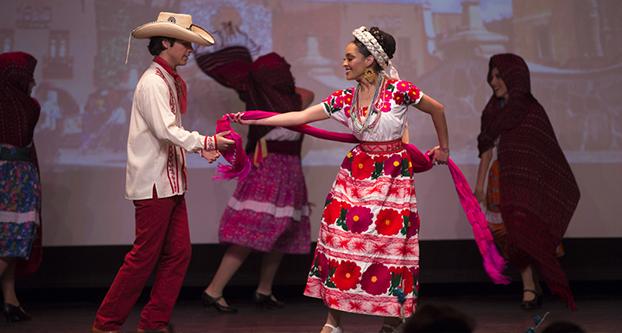Los Danzantes de Aztlán tapped their shoes, waved their dresses and welcomed in the Christmas season in front of a packed Satellite Student Union (SSU) last Saturday with the 30th rendition of their “Christmas in Mexico” show.
The audience made its presence known throughout the entire night. The dancers’ Mexican shouts were echoed with an equal amount from the audience.
The 800 seats in the SSU had trouble seating everyone. Some people were asked to stand.
That caused a security problem, and in order to get everyone into a seat the music was stopped in the middle of Los Danzantes de Aztlán’s performance of a dance from the Hidalgo region.
The dancers finished their performance nonetheless. The audience rewarded them with the most thunderous cheer of the night.
“To be honest, it was really freaking empowering,” said Austin Romo, a dancer and Fresno State student. “It was like we said, ‘Screw you, man. We’re gonna do this.’”
Parra added that it felt good to have “la raza” behind them in such a difficult moment.
Los Danzantes de Aztlán, according to its website, was founded in 1970 by professor Ernesto Martinez in the department of Chicano and Latin American studies at Fresno State. The goal of the group was to showcase the many regional dances of Mexico.
The “Christmas in Mexico” performance was a two-hour showcase of folklorico dance. The Danzantes received help from a number of other dance groups.
Fresno City College, Central High School and Clovis High School all contributed their own performances. Los Danzantes Juvenil, an all-children extension of Los Danzantes de Aztlán, also performed.
The night opened with speeches of gratitude. The first was from Dr. Victor Torres, professor in the department of Chicano and Latin American Studies at Fresno State and director of Los Danzantes de Aztlán.
“We are happy that 30 years later this tradition has continued here at Fresno State,” Torres said of the show.
Dr. Christina Herrera, chair of the department; Dr. Michelle DenBeste, dean of the College of Social Sciences; and Dr. Saúl Jiménez-Sandoval, dean of the College of Arts and Humanities, all followed suit.
“For over 40 years, Los Danzantes de Aztlán have served as a symbol of the beauty of our Mexican-American and Chicano culture, and the resiliency of our people,” Herrera said. “I’m deeply honored to be here at an event that not only showcases Dr. Torres’ commitment to folkloric dance, but also the students’ hard work.”
After the opening speeches, the performers were able to begin their dances.
Each performance showcased a different region of Mexico in its dance. There were 11 dances and 11 regions represented. Each region gave its own flare and uniqueness via attire and dance styles, making no dance too similar to the next.
The Yucatan region, performed by Los Danzantes de Aztlán, featured the women decorated in colorful floral dresses and had their hair dressed with flowers similar to those on their dresses.
The dance incorporated handheld fans and rebozos into the choreography.
“As we learn new material, we’re learning about the culture. When we learn a new region, it’s like ‘Wow,’ you know?” Estevan Parra, one of the Danzantes, said. “It’s beautiful to know the origin of how this song was created, [and] how this dance was created.”
Parra added how much his time as a dancer for this dance company has helped him garner pride in his Mexican heritage, something he said he never really felt before.
Some of the dances, like the one that showcased the Baja California region that was performed by Fresno City College students, featured a fast-paced rendition of the folkloric dance ”’ a style influenced by Europe that was heavy with tapping and traditional Mexican shouts.
Other regions, like Veracruz — performed by Clovis High School students — took a much more patient and serene route. This dance emphasized slow music, long and fluid motions, and the female dancers balanced a candle on their heads throughout it all.
Julisa Maldonado, who came to watch her niece, said, “I was Googling some of the Mexican states that they were mentioning, just looking at the geography, and the costume changes.”
After all of the performances were through, the show transitioned into a raffle of gift baskets and an auction of some PINK clothing.
Torres concluded the show with an extension of gratitude to each and every one of the dancers in his group.




